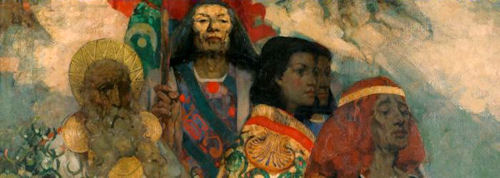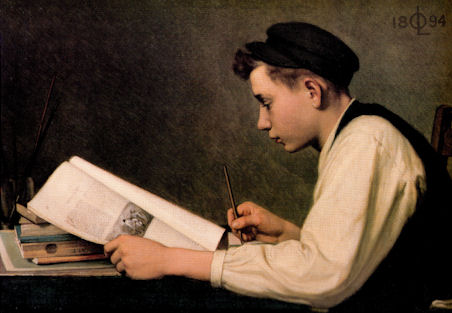




It appears to me that few will argue with my opinion that Dear Frankie is neither Fairy Tale, and romantic comedy; nor Myth, by way of opera and Greek tragedy. And yet there's definitely a timeless quality to the film, as of the updating of a very old story. (See Part 1B:— Benevolent Impersonation).
Which brings us to the subject of benevolence, until now treated merely for its value in the context of romantic comedy impersonation. Could we agree that from first to last Dear Frankie is a film about benevolence? — beginning with Frankie's tranquil acceptance of yet another uprooting from one place to the next:—
Ma says it's time. She says that it's definitely the last time. But she says that every single time.
How much attention to detail has been spent ensuring such tranquillity, as the boy packs up his own toys and belongings with the efficiency born of experience, and the certainty that his treasures will arrive when he does? — And his room! No sign there of the poverty apparent in every other corner of the apartment.
Most of us, I imagine, would reach our limits of generosity by forbearing to criticize the absent father — Lizzie has gone countless miles beyond by creating for Frankie a marvellous Da, a seaman who sends letters and stamps to a son he is unable to see but obviously holds dear.
Robert Burns in To A Mouse assures us that the best laid schemes o' mice an' men will gang aft a-gley. But had they not, surely the dreary cycle of apprehended threat and flight would have continued until Davey's death, with no opportunity for Lizzie to find sanctuary by her own means and efforts?
In his essay The Luxury of Doing Good, Irish writer Stephen Gwynn (1864-1950) reflected at some length upon benevolence, beginning with a rather thought-provoking quotation from Hobbes:—
...
'Benevolence,' said
Hobbes, 'is a love of power and
delight in the exercise of it.' ...
It is an axiom of conduct,
Gwynn continues, that if you want a thing
done you should go to the busiest man of your acquaintance;
and we all act upon this maxim without reflecting that it
concedes the theory that benevolence is a love of power ...
Two things go to make up benevolence — sympathy
and energy — and for practical purposes energy is
the more important ...
But what good is energy without sympathy? We are reminded of The Stranger insisting that Lizzie be an integral part of the Sunday expedition, and are entitled to suspect that he knew quite well that Lizzie had been an unacknowledged participant the previous day, trying to keep out of sight as she shadowed their every footstep.
...
The essence of benevolence lies in giving help which
is both given and received with pleasure, and no
right-minded person can feel a pleasure in giving what
cannot be accepted without a sense of humiliation.
Power. Humiliation. In Benevolent Impersonation already mentioned I suggested that successful romantic comedies (Working Girl, Pretty Woman) — to say nothing of timeless Novels such as Jane Austen's Pride and Prejudice — end when the two protagonists have attained equality.
No equality is possible at this time between Lizzie Morrison and The Stranger.
Which is why the film ends as it must.
With Marie and her fish shop, The Stranger and the community centre, to say nothing of Buck Owen's Great White Horse, shown unmistakeably for what they are:— stepping stones, as much as destinations.
As for the retelling of an old story, I wonder if Dear Frankie hasn't much to do with a very beautiful but non-traditional icon I was given some years ago. Most icons contain only Mother and Child; Joseph is of primary importance in the representation I was given. I wouldn't value it as highly if he weren't.
Joseph. The man with the halo, and richly deserved, what's more.
According to the opening chapter of the Gospel according to Matthew, when Mary, his espoused, was discovered to be with child:—
' [19] Then Joseph her husband, being a just man, and not willing to make her a publick example, was minded to put her away privily ... '
But after a dream he decided instead to proceed with the marriage and to be to their Child the best father he knew how to be — thus satisfying every requirement for true benevolence.
Today our traditions of benevolence have devolved mainly to secular agencies and institutions. But the highest standards are inescapable in a society of blended families, where Christmas is still celebrated, and the example of Joseph has never been more relevant. And Stephen Gwynn hasn't finished:—
...
There is a kind of benevolence ... which is always willing,
and even anxious, to help its neighbour, but not as the neighbour
desires to be helped.
In our present times when even high school students are given the responsibility of using their sympathy and surplus energies in serving the needs of the less fortunate, shouldn't Joseph — and Dear Frankie's The Stranger — serve as a model? — Always ensuring that we not use our superior power to keep the recipients of our benevolence helpless and dependent, in order to use them for our own purposes? — Always ready to step back and allow them the dignity of learning to manage on their own, thus attaining equality with us?
In any event, for me it's the filmmakers' insistence on refraining from the inordinate pressures surely they must have been under to turn their story into Fairy Tale or Myth that raises Dear Frankie to the level of a masterpiece. The film simply exists in a special niche of its own.
And not coincidentally it permits me to end this website as it was begun, and continued from section to section, with an emphasis on finding a place where one is accepted, where one belongs and can flourish. Need I explain that this was never my original intention and that I'm as surprised as anyone to discover it?
. . . . .
When first begun in 2003, these Sandsifter Five Retrospectives were meant as a meat and potatoes outdoor picnic, plain print on cream-coloured paper. And then it became necessary to move the picnic indoors, and the picnic became a sort of dinner party, almost a banquet, as each course required different invited guests for witty quotations, and changed wall hangings to match up with altered subject matter.
Some banquet — with only dessert in the form of Dear Frankie completed and set out to prevent starvation with the first and best episodes of Blackpool as apéritif. Meanwhile Seinfeld remains below the boil for eventual sauces and other accompaniments, while Star Trek chills in the wine cellar.
And tomorrow I will start final preparation of the soup, otherwise known as Fairy Tale and Myth, with the other Novels of Jane Austen as breads and salads, to be followed by the main course entrée of Pride and Prejudice, to which I promise to devote all my time and energies and with no more digressions.
I should be wishing my guests a fond goodbye at this point, but instead invite them back:—
Soyez les bienvenu(e)s !
Welcome !
________________________